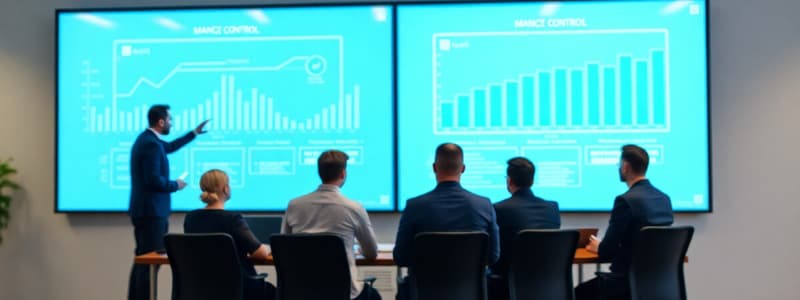Podcast
Questions and Answers
Which type of control focuses on addressing issues as they arise during the work process?
Which type of control focuses on addressing issues as they arise during the work process?
- Feedforward control
- Bureaucratic control
- Concurrent control (correct)
- Feedback control
What is the primary aim of feedforward controls?
What is the primary aim of feedforward controls?
- To encourage self-control among employees.
- To prevent problems before they occur. (correct)
- To evaluate and correct actions after the project is completed.
- To solve external problems as they are occurring.
Which control type relies heavily on organizational culture and shared values to influence behavior?
Which control type relies heavily on organizational culture and shared values to influence behavior?
- Market Control
- Strategic Control
- Clan Control (correct)
- Bureaucratic Control
Why might a company implement bureaucratic controls?
Why might a company implement bureaucratic controls?
An organization is implementing a new customer relationship management (CRM) system. Which of the following is an example of a feedforward control?
An organization is implementing a new customer relationship management (CRM) system. Which of the following is an example of a feedforward control?
What is the primary focus of strategic control?
What is the primary focus of strategic control?
When should managers consider using input standards in the control process?
When should managers consider using input standards in the control process?
In the control process, what is the purpose of comparing actual performance with objectives and standards?
In the control process, what is the purpose of comparing actual performance with objectives and standards?
What does the Pareto principle suggest about performance objectives?
What does the Pareto principle suggest about performance objectives?
What is 'management by exception'?
What is 'management by exception'?
What is a key challenge in project management regarding delays?
What is a key challenge in project management regarding delays?
What is the primary purpose of a Gantt chart in project management?
What is the primary purpose of a Gantt chart in project management?
How does just-in-time (JIT) scheduling contribute to inventory control?
How does just-in-time (JIT) scheduling contribute to inventory control?
In break-even analysis, what does the break-even point represent?
In break-even analysis, what does the break-even point represent?
A company has fixed costs of $50,000, a selling price of $25 per unit, and variable costs of $15 per unit. What is the break-even point in units?
A company has fixed costs of $50,000, a selling price of $25 per unit, and variable costs of $15 per unit. What is the break-even point in units?
Which financial statement shows a company's assets, liabilities, and owner's equity at a specific point in time?
Which financial statement shows a company's assets, liabilities, and owner's equity at a specific point in time?
What does the financial ratio 'net income/sales' indicate?
What does the financial ratio 'net income/sales' indicate?
Why is liquidity an important measure of financial performance?
Why is liquidity an important measure of financial performance?
What is the purpose of a balanced scorecard?
What is the purpose of a balanced scorecard?
Which of the following questions aligns with the 'internal process improvement' perspective of a balanced scorecard?
Which of the following questions aligns with the 'internal process improvement' perspective of a balanced scorecard?
Which of the following is an example of a feedback control?
Which of the following is an example of a feedback control?
Which condition is most likely to foster effective self-control in the workplace?
Which condition is most likely to foster effective self-control in the workplace?
A Chief Compliance Officer (CCO) is appointed within an organization. To whom should the CCO ideally report to ensure maximum effectiveness and independence?
A Chief Compliance Officer (CCO) is appointed within an organization. To whom should the CCO ideally report to ensure maximum effectiveness and independence?
A company decides to adopt a 'green' product line in response to growing environmental awareness among consumers. Which type of control does this best exemplify?
A company decides to adopt a 'green' product line in response to growing environmental awareness among consumers. Which type of control does this best exemplify?
What is the primary function of the economic order quantity (EOQ) model?
What is the primary function of the economic order quantity (EOQ) model?
Flashcards
Controlling (in management)
Controlling (in management)
The ongoing process of measuring performance and ensuring that plans are achieved as intended.
After-action review
After-action review
A structured review of completed projects to analyze lessons learned and results achieved, promoting continuous improvement.
Feedforward control
Feedforward control
Control that takes place before work begins, ensuring clear objectives, proper directions, and resource availability for success.
Concurrent controls
Concurrent controls
Signup and view all the flashcards
Feedback controls
Feedback controls
Signup and view all the flashcards
Self control (in management)
Self control (in management)
Signup and view all the flashcards
Bureaucratic control
Bureaucratic control
Signup and view all the flashcards
Clan control
Clan control
Signup and view all the flashcards
Strategic control
Strategic control
Signup and view all the flashcards
Market control
Market control
Signup and view all the flashcards
Output standards
Output standards
Signup and view all the flashcards
Input standards
Input standards
Signup and view all the flashcards
Control Equation
Control Equation
Signup and view all the flashcards
Management by exception
Management by exception
Signup and view all the flashcards
Projects
Projects
Signup and view all the flashcards
Project management
Project management
Signup and view all the flashcards
Gantt chart
Gantt chart
Signup and view all the flashcards
CPM/PERT
CPM/PERT
Signup and view all the flashcards
Inventory control
Inventory control
Signup and view all the flashcards
Economic order quantity
Economic order quantity
Signup and view all the flashcards
Just-in-time scheduling
Just-in-time scheduling
Signup and view all the flashcards
Break-even point
Break-even point
Signup and view all the flashcards
Break-Even Formula
Break-Even Formula
Signup and view all the flashcards
Break-even analysis
Break-even analysis
Signup and view all the flashcards
Balanced scorecard
Balanced scorecard
Signup and view all the flashcards
Study Notes
Why and How Managers Control
- Controlling is measuring performance and ensuring plans are realized.
- Information serves as the basis for control
- Benefits of controlling include organizational learning.
- After-action reviews are structured reviews of lessons learned and results accomplished in a project.
- After-action reviews makes continuous improvement a shared norm.
Types of Control
- Feedforward controls (preliminary controls) occur before the work or activity begins.
- Feedforward controls ensure clear objectives, proper directions, and available resources.
- Concurrent controls focus on what happens during the work process, like direct supervision.
- Feedback controls (post-action controls) happen after the work is completed.
- Feedback controls emphasizes the quality of end results.
Internal and External Control
- Managers can trust people to control themselves or structure situations for control.
- Self-control is fostered by participation, empowerment, involvement, and a clear sense of mission and goals.
- Bureaucratic control is external and uses authority, policies, procedures, job descriptions, budgets, and supervision.
- Clan control (normative control) influences behavior through norms and expectations set by the organizational culture.
- Strategic control guides an organization through unanticipated events during project implementation.
- Market control is the influence of customers and competition on organizational behavior.
The Control Process
- Involves four steps: establishing objectives and standards, measuring performance, comparing performance to standards, and taking corrective action.
- Focus on critical results when setting objectives.
- The Pareto principle states that 80% of consequences come from 20% of causes.
- Output standards measure actual outcomes.
- Input standards measure work efforts.
- Actual performance is measured using output and input standards.
- The control equation is: Need for action = Desired performance - Actual performance.
- Historical comparisons use past experience to evaluate current performance.
- Management by exception is giving attention to situations with the greatest need for action.
- Problem situations are where actual performance is less than desired.
- Opportunity situations are where performance exceeds expectations.
Control Tools and Techniques
- Projects are one-time events with unique components and time constraints.
- Project management oversees planning, supervision, and control to ensure timely and within-budget completion.
- Gantt charts visually display the scheduling of project tasks.
- CPM/PERT (Critical Path Method/Program Evaluation and Review Technique) breaks projects into sub-activities to ensure the right sequence of events.
- Inventory control minimizes inventory size to meet immediate needs and reduce carrying costs.
- Economic Order Quantity (EOQ) automatically orders a fixed number of items when inventory falls to a set level.
- Just-in-time (JIT) scheduling delivers materials just in time for use, reducing inventory costs.
- The break-even point is where revenues equal costs, calculated as: Fixed Costs / (Price - Variable Cost).
- Break-even analysis is a what-if calculation under different cost and revenue conditions.
Financial Controls
- Financial controls use the balance sheet and income statement.
- The balance sheet shows assets, liabilities, and owner's equity at a point in time: Assets = Liabilities + Owner's Equity.
- The income statement shows profits or losses over a period: Sales - Expenses = Net Income.
- Financial ratios assess liquidity, leverage, asset management, and profitability.
- Liquidity measures the ability to pay short term bills
- Leverage measures the ability to earn more in returns than the cost of dept
- Asset management measures the ability to use resources efficiently and operate at minimum cost
- Profitability measures the ability to earn revenues greater than costs
- Key ratios include:
- Net Margin (Net Income / Sales).
- Return on Assets (Net Income / Total Assets).
- Return on Equity (Net Income / Owner's Equity).
Balanced Scorecards
- Balanced scorecards provide a comprehensive view of a business.
- Developing a scorecard starts with clarifying the organization's mission and vision.
- Considers measures of:
- Financial performance.
- Customer satisfaction.
- Internal process improvement.
- Innovation and learning.
Studying That Suits You
Use AI to generate personalized quizzes and flashcards to suit your learning preferences.




